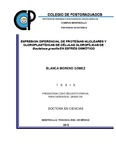| dc.contributor.author | Moreno Gómez, Blanca | |
| dc.contributor.author | MORENO GOMEZ, BLANCA | |
| dc.creator | MORENO GOMEZ, BLANCA; 209601 | |
| dc.date.accessioned | 2018-09-21T18:24:39Z | |
| dc.date.available | 2018-09-21T18:24:39Z | |
| dc.date.issued | 2015 | |
| dc.identifier.uri | http://hdl.handle.net/10521/2871 | |
| dc.description | Tesis (Doctorado en Ciencias, especialista en Botánica).- Colegio de Postgraduados, 2015. | es_MX |
| dc.description.abstract | Las suspensiones celulares clorofílicas y mutantes de Bouteloua gracilis son un modelo único en el mundo dentro de la familia de las gramíneas que es ideal para el estudio de las respuestas celulares a estreses abióticos, como estrés hídrico o salino. Debido a su elevada resistencia al estrés osmótico, a la presencia de cloroplastos desarrollados, a la acumulación de altos niveles de clorofila, a la sintenia y semejanza de su genoma con el de algunos cereales de importancia agrícola y al confinamiento en los cloroplastos de ciertas enzimas que son fundamentales para la respuesta vegetal a los factores ambientales, las suspensiones celulares clorofílicas de B. gracilis constituyen un modelo único para el estudio y el análisis de la respuesta de las plantas al estrés hídrico a nivel celular. Actualmente, la participación de los cloroplastos en la respuesta de las plantas al déficit hídrico ha sido poco estudiada. Sin embargo, el empleo de herramientas bioquímicas y moleculares, como la proteómica, nos permite estudiar las proteínas nucleares y cloroplastídicas de respuesta a estrés osmótico, conocimiento necesario para poder dilucidar algunas de las funciones enzimáticas codificadas en los cloroplastos que están relacionadas con la respuesta de las plantas al estrés hídrico y osmótico. En el presente estudio se lograron identificar proteínas diferenciales entre una línea celular clorofílica y una línea silvestre mutante carente de clorofila, así como algunas proteínas de respuesta a estrés osmótico en las células silvestres de Bouteloua gracilis. Estos resultados sientan las bases para el diseño de estrategias biotecnológicas que permitan reducir el impacto del estrés hídrico y mejorar la productividad vegetal. _______________ DIFFERENTIAL EXPRESSION OF NUCLEAR AND CHLOROPLAST PROTEINS OF CHLOROPHYLLIC AND MUTANTS CELLS FROM Bouteloua gracillis IN CONDITIONS OF OSMOTIC STRESS. ABSTRACT: Chlorophyllic and mutants cell suspensions of Bouteloua gracilis are a unique model in the world within the grass family, which is ideal for studying cellular responses to abiotic stresses such as water or saline stress. Due to its high resistance to osmotic stress, to the presence of well-developed chloroplasts, to the accumulation of high levels of chlorophyll, to the genetic similarity and synteny to the the genomes of some agriculturally important cereals and to the confinement of some enzymes, which are fundamental for the plant response to the environmental factors, the chlorophyllic cells suspensions of B. gracilis are a unique model for the study and analysis of the plant response to water stress at the cellular level. Currently, the participation of chloroplasts in the plant response to water deficit has been partially studied. However, the use of biochemical and molecular tools, such as proteomics, allow to study nuclear and chloroplast proteins which are responsive to osmotic stress, knowledge that is necessary for elucidating some of the enzymatic functions encoded in chloroplasts which are related to the plant response to water and osmotic stress. In the present study, we were able to identify diferential proteins between a wild type-chlorophyllic green cell line and a yellow mutant cell line that is devoid of chlorophyll, as well as some responsive proteins to water stress in the B. gracilis wild type cells. These results provide the basis for designing of biotechnological strategies aimed to reduce the impact of water stress and improve the productivity of plants. | es_MX |
| dc.description.sponsorship | Consejo Nacional de Ciencia y Tecnología (CONACyT). | es_MX |
| dc.format | pdf | es_MX |
| dc.language.iso | spa | es_MX |
| dc.rights.uri | http://creativecommons.org/licenses/by-nc-nd/4.0 | es_MX |
| dc.subject | Bouteloua gracilis | es_MX |
| dc.subject | Estrés hídrico | es_MX |
| dc.subject | Cloroplastos | es_MX |
| dc.subject | Proteómica | es_MX |
| dc.subject | Water stress | es_MX |
| dc.subject | Chloroplast | es_MX |
| dc.subject | Proteomic | es_MX |
| dc.subject | Botánica | es_MX |
| dc.subject | Doctorado | es_MX |
| dc.subject.classification | CIENCIAS AGROPECUARIAS Y BIOTECNOLOGÍA::CIENCIAS AGRARIAS::AGRONOMÍA::PROTECCIÓN DE LOS CULTIVOS | es_MX |
| dc.title | Expresión diferencial de proteínas nucleares y cloroplastídicas de células clorofílicas de Bouteloua gracilis en estrés osmótico. | es_MX |
| dc.type | Tesis | es_MX |
| Tesis.contributor.advisor | Conde Martínez, Florentino Víctor | |
| Tesis.contributor.advisor | Aguado Santacruz, G. Armando | |
| Tesis.contributor.advisor | García Moya, Edmundo | |
| Tesis.contributor.advisor | Robledo Paz, Alejandrina | |
| Tesis.contributor.advisor | Delgado Alvarado, Adriana | |
| Tesis.date.submitted | 2015 | |
| Tesis.date.accesioned | 2016 | |
| Tesis.date.available | 2016 | |
| Tesis.type | Tesis | es_MX |
| Tesis.format.mimetype | pdf | es_MX |
| Tesis.format.extent | 1,414 KB | es_MX |
| Tesis.subject.nal | Estrés osmótico | es_MX |
| Tesis.subject.nal | Osmotic stress | es_MX |
| Tesis.subject.nal | Estrés salino | es_MX |
| Tesis.subject.nal | Salt stress | es_MX |
| Tesis.subject.nal | Clorofila | es_MX |
| Tesis.subject.nal | Chlorophyll | es_MX |
| Tesis.subject.nal | Factores ambientales | es_MX |
| Tesis.subject.nal | Environmental factors | es_MX |
| Tesis.rights | Acceso abierto | es_MX |
| Articulos.subject.classification | Plantas-efecto del estrés | es_MX |
| dc.type.conacyt | doctoralThesis | es_MX |
| dc.identificator | 6||31||3103||310304 | es_MX |
| dc.contributor.director | CONDE MARTINEZ, FLORENTINO VICTOR; 53111 | |
| dc.audience | generalPublic | es_MX |


